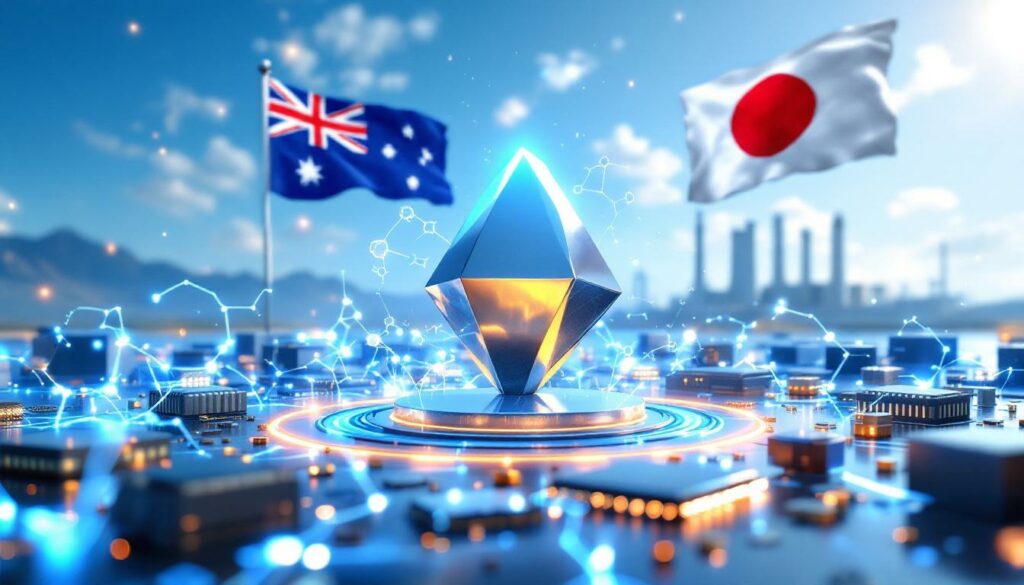Understanding Gallium: The Critical Metal Powering Modern Technology
Gallium may not be a household name, but this soft, silvery metal has become an essential component in today's high-tech world. With unique properties that make it irreplaceable in numerous applications, gallium has risen to strategic importance in global technology supply chains. As China controls approximately 80% of global gallium production and implemented export restrictions in 2023, countries and companies are now racing to develop alternative sources – with Alcoa exploring gallium production in WA operations potentially playing a crucial role.
The Versatile Applications of Gallium
Gallium's remarkable properties have made it indispensable across multiple high-value industries. Unlike many metals, gallium has an unusually low melting point (29.76°C/85.57°F), meaning it can literally melt in your hand, while maintaining stability in higher temperatures when alloyed with other elements.
The metal truly shines when combined with other elements to form compounds with exceptional semiconductor properties:
- Gallium arsenide (GaAs) powers high-frequency, high-power electronics in telecommunications
- Gallium nitride (GaN) enables ultra-efficient power conversion in electric vehicles and renewable energy systems
- Gallium oxide (Ga₂O₃) shows promise for next-generation power electronics with superior performance
These compounds support critical applications including:
- High-performance semiconductor chips for data centers and AI systems
- Energy-efficient LED lighting that has revolutionized global illumination
- Photovoltaic cells in high-efficiency solar panels
- 5G and advanced wireless communications infrastructure
- Radar systems and electronic warfare equipment
- Medical imaging technologies like MRI machines
Technical insight: Gallium nitride's wide bandgap properties allow it to operate at higher temperatures, voltages, and frequencies than traditional silicon, making it crucial for next-generation power electronics.
Alcoa's Strategic Move into Gallium Production
Alcoa of Australia has announced a significant joint development agreement with Japan Australia Gallium Associates (JAGA) to explore gallium production possibilities at its existing operations in Western Australia. This strategic partnership represents a potential breakthrough in diversifying global gallium supply chains away from Chinese dominance.
Partnership Structure and Expertise Combination
The collaboration brings together complementary strengths from both organizations:
- Alcoa contributes its established alumina refining infrastructure and bauxite processing expertise in Western Australia
- JAGA provides specialized gallium extraction knowledge as a joint venture between:
- Sojitz Corporation – A Japanese trading company with extensive connections to midstream gallium refiners and manufacturers
- Japan Organisation for Metals and Energy Security – A government entity focused on securing critical minerals energy supplies
This alliance aims to determine whether co-locating gallium production facilities at one of Alcoa's existing WA refineries makes technical and economic sense. The partnership effectively combines Alcoa's processing capabilities with JAGA's market connections and technical expertise.
Ambitious Timeline for Market Entry
The partnership has established an accelerated timeline that reflects the urgency of establishing non-Chinese gallium supply chains:
| Milestone | Target Date |
|---|---|
| Feasibility Study Completion | 2024-2025 |
| Final Investment Decision | Before end of 2025 |
| Initial Production | As early as 2026 |
| Full-Scale Operations | To be determined |
Elsabe Muller, Alcoa of Australia president, highlighted the strategic importance of this initiative: "This opportunity could deliver additional value from our established operations and further demonstrate how Alcoa's longstanding mineral processing capabilities can be significant in supporting state, national and global objectives in technology and national defence."
Muller also emphasized the value of working with experienced partners: "We welcome the opportunity to work with the JAGA partners, including Sojitz, who has considerable connection with midstream gallium refiners and manufacturers and would be an offtake customer in the project."
The Science Behind Gallium Extraction from Alumina Processing
Unlike many metals that occur in concentrated ore deposits, gallium is rarely found in pure form in nature. Instead, it exists as trace elements dispersed throughout other minerals, particularly in bauxite (aluminum ore), zinc ores, and some coal deposits. This distribution pattern makes gallium extraction uniquely suited to recovery as a by-product of existing mineral processing operations.
Gallium's Presence in the Alumina Production Chain
Alcoa's existing alumina refineries in Western Australia already process bauxite containing trace amounts of gallium – typically 30-80 parts per million. During the standard Bayer process used for alumina production, gallium follows similar chemical pathways to aluminum, becoming concentrated in certain process streams.
This natural concentration creates an opportunity to extract gallium without requiring new mining operations, effectively leveraging existing infrastructure and material flows that are already being processed.
Technical Extraction Methods and Challenges
Extracting gallium from alumina production involves several specialized techniques:
- Separation from process liquors – Gallium concentrates in the sodium aluminate solution during bauxite processing
- Chemical extraction – Specialized chemicals selectively bind with gallium ions
- Purification processes – Multiple refining steps to achieve semiconductor-grade purity (99.99999%)
- Integration with existing operations – Designing systems that don't disrupt alumina production
The technical complexity centers on extracting tiny amounts of gallium (measured in parts per million) efficiently enough to be economically viable while meeting the ultra-high purity standards required for semiconductor applications.
Technical consideration: The extraction process must balance recovery rates, energy consumption, chemical usage, and capital costs against expected gallium prices and production volumes.
The Global Rush for Gallium Supply Diversification
The global gallium market has experienced significant disruption in recent years, creating both challenges and opportunities for new producers outside traditional supply centers.
China's Market Position and Export Restrictions
China's dominance in gallium production stems from its extensive aluminum industry and deliberate investment in gallium recovery technology. Key facts about China's market position include:
- China produces approximately 80% of the world's gallium supply
- In 2023, China implemented export controls on gallium, designating it as a strategic resource
- These restrictions were part of broader controls on critical minerals with dual-use applications
- The measures created immediate concerns about supply chain resilience in semiconductor manufacturing
These export controls triggered price volatility and accelerated interest in developing alternative supply sources in countries like Australia, creating the market opening that Alcoa and JAGA are now exploring.
Critical Mineral Status and Strategic Importance
Gallium has gained official recognition as a strategic resource by multiple governments:
- Australia includes gallium on its Critical Minerals List
- The United States designates gallium as a critical mineral essential for economic and national security
- The European Union classifies gallium among its Critical Raw Materials
- Japan actively seeks secure supply chains for technology minerals including gallium
This strategic designation has led to policy support for domestic production, including:
- Research and development funding for extraction technologies
- Streamlined permitting for critical mineral projects
- International cooperation agreements between allied nations
- Strategic mineral stockpiling initiatives like Australia's strategic reserve
As digital technologies and renewable energy systems continue expanding globally, securing stable gallium supplies has become a priority for technology-focused economies.
Economic Benefits of Gallium Production for Western Australia
Establishing gallium production in Western Australia could deliver significant economic advantages beyond direct mining revenues, creating a multiplier effect across the state's economy.
Value-Added Processing Opportunities
The proposed gallium extraction represents a classic value-added processing opportunity:
- Higher returns from existing operations – Extracting additional value from already-mined material
- Processing premium – Capturing more of the value chain by producing refined materials rather than raw resources
- Economic diversification – Expanding beyond traditional bulk commodity exports
- Technological advancement – Building expertise in critical mineral processing
- Supply chain positioning – Establishing Western Australia in high-tech material supply networks
As Alcoa of Australia president Elsabe Muller noted, this opportunity could "deliver additional value from our established operations" while simultaneously supporting broader strategic objectives in technology and defense sectors.
Employment and Industry Development Benefits
Beyond direct economic returns, gallium production could contribute to Western Australia's economic ecosystem through:
- Creation of specialized technical jobs in advanced materials processing
- Knowledge transfer and skills development in critical minerals extraction
- Research collaboration opportunities with universities and technology companies
- Potential for downstream manufacturing of gallium-based materials
- Enhanced global positioning as a trusted supplier of critical technology inputs
These broader economic impacts align with both Western Australia's resource strategy and federal initiatives to move Australia up the critical minerals value chain, similar to the potential bauxite project benefits seen in other initiatives.
Gallium Production in Global Critical Minerals Strategies
The Alcoa-JAGA partnership exemplifies a broader global trend toward restructuring critical mineral supply chains to enhance security and resilience.
The New Geography of Critical Minerals Supply
Countries are increasingly working to reduce overreliance on single-source suppliers for materials essential to technology manufacturing and defense systems. This restructuring involves:
- Friend-shoring – Developing supply chains among geopolitically aligned nations
- Supply diversity – Creating multiple sources to reduce vulnerability to disruptions
- Processing capacity development – Building expertise outside traditional centers
- Strategic partnerships – Forming cross-border alliances between companies and governments
The Alcoa initiative represents this trend in action, with Australian processing capacity partnering with Japanese technical expertise and market access to create an alternative supply path for a critical technology material, in line with the broader critical minerals strategy.
Japan's Resource Security Approach
Japan's involvement through JAGA highlights its sophisticated approach to resource security:
- As a resource-poor island nation, Japan has developed extensive strategies for securing critical materials
- The Japan Organisation for Metals and Energy Security actively supports overseas resource development
- Japanese trading companies like Sojitz play crucial roles in establishing global supply networks
- Government-industry partnerships focus on materials essential for Japan's technology-focused economy
For Japan, this partnership represents an opportunity to secure gallium supplies from a politically stable ally while potentially creating preferred access for Japanese manufacturers in semiconductor and electronics industries.
Overcoming Challenges for Successful Gallium Production
While the potential benefits are significant, the Alcoa-JAGA partnership must overcome several substantial challenges before commercial production becomes reality.
Technical and Economic Feasibility Hurdles
The joint development agreement will need to address key questions including:
- Extraction efficiency – Determining optimal gallium recovery rates from Alcoa's specific process streams
- Capital requirements – Calculating the investment needed for specialized equipment and facilities
- Operational costs – Projecting ongoing expenses for chemicals, energy, and specialized labor
- Production scale – Assessing whether potential gallium volumes justify the investment
- Product specifications – Confirming ability to meet stringent purity requirements for semiconductor applications
The feasibility assessment will need to determine whether the project can achieve competitive production costs compared to established suppliers, particularly when Chinese export restrictions potentially ease.
Market and Competitive Considerations
Beyond technical feasibility, market factors will significantly impact the project's success:
- Pricing volatility – Gallium prices have fluctuated significantly in response to supply restrictions
- Market size limitations – The global gallium market remains relatively small compared to mainstream metals
- Competing projects – Other countries and companies are also exploring alternative gallium sources
- Technological substitution – Research into alternative materials could potentially reduce gallium demand
- Offtake arrangements – Securing committed customers is essential for project financing
Market reality: While current gallium prices may support new production, investment decisions must consider long-term price projections after initial supply shortages are addressed.
FAQ: Understanding Gallium Production and Applications
What exactly makes gallium so important for modern technology?
Gallium compounds offer unique electronic properties that cannot be replicated by other materials. Gallium arsenide (GaAs) and gallium nitride (GaN) semiconductors operate at higher frequencies and with greater energy efficiency than silicon-based alternatives. These properties are essential for applications requiring high performance, including satellite communications, radar systems, 5G networks, and power electronics in electric vehicles.
How is gallium typically extracted from alumina refineries?
Gallium extraction from alumina refineries involves intercepting specific process streams where gallium becomes concentrated during the Bayer process. The primary methods include:
- Solvent extraction using specialized organic compounds that selectively bind with gallium
- Electrochemical processes that deposit gallium from solution
- Ion exchange techniques using specially designed resins
- Fractional precipitation to separate gallium from other elements
After initial extraction, the gallium undergoes multiple purification steps to achieve the 99.99999% purity (7N) required for semiconductor applications.
What quantities of gallium could Alcoa potentially produce?
While specific production targets haven't been announced, industry analysts suggest that an integrated gallium extraction facility at a major alumina refinery could potentially produce several metric tons annually. Global gallium production is relatively small compared to mainstream metals, with worldwide production estimated at approximately 500 metric tons annually. Even modest production from Alcoa's operations could represent a significant addition to non-Chinese supply.
How might this project impact global gallium markets?
If successful, Alcoa exploring gallium production in WA could help diversify global supply chains, potentially:
- Reducing price volatility by creating more stable and predictable supply sources
- Providing technology manufacturers with supply chain alternatives outside China
- Establishing Australia as a significant producer in the critical minerals landscape
- Creating a template for other alumina producers to follow in recovering critical minerals
- Supporting broader allied nation strategies for technology mineral security
The project's impact will depend on production volumes achieved, timing relative to market developments, and how competing projects progress simultaneously.
Exploring Australia's Critical Minerals Future
The Alcoa gallium initiative represents just one facet of Australia's broader opportunity in critical minerals. As global technology transitions accelerate toward renewable energy, electrification, and advanced computing, the demand for specialized materials continues growing. Western Australia's established mining industry, processing expertise, and stable political environment position it ideally to become a preferred supplier of these essential resources.
For industry stakeholders interested in following these developments, the implementation of data-driven mining operations will be crucial to maximizing efficiency and output in these specialized extraction processes.
Ready to Spot the Next Major Mineral Discovery?
Investors seeking early market advantages can receive real-time alerts on significant ASX mineral discoveries through Discovery Alert's proprietary Discovery IQ model, which transforms complex mineral data into actionable insights. Explore the exceptional returns from historic discoveries by visiting Discovery Alert's dedicated discoveries page and position yourself ahead of the market.




